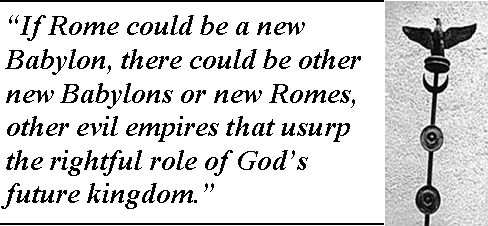Rightly Understanding God’s Word: Context of Genre, Revelation, by Craig S. Keener
Jesus invites everyone to listen in on his message to each of the churches.
Whole-book context also offers insight into what Revelation may mean when it mentions the mark of the beast. Should we preach about that by simply warning people to avoid something in the future, or does it have something to teach us in the present? Against what most of us have been taught, a consistent reading with the rest of Revelation suggests that this mark may not be visible to people. Notice the other marks written on people in the book of Revelation. For example, believers will become pillars in God’s future temple, and just as other ancient pillars had names inscribed on them, so we will have God’s name and the name of the New Jerusalem inscribed on us (3:12; cf. 2:17). Forever God’s and the lamb’s name will be written on our foreheads (22:4), perhaps like a slave brand or some other kind of brand showing to whom we belong. Jesus comes back with a name written on his thigh (19:12-13, 16), perhaps so John could read his title in the vision. Babylon the great has a name written on her forehead (17:5), but just as Babylon is not a literal woman, we recognize that the inscription is part of the vision, not literally written on a woman’s head.
Just like God placed a mark on the righteous in Ezekiel 9:4-6, so God seals the 144,000 to protect them during his judgments (Rev 7:3). As in Ezekiel, this is a mark that only God himself sees. Because there were no chapter breaks in the original Bible, the first readers would have readily noticed the contrast between the 144,000 and the rest of the world (13:16—14:5). Those who follow the beast bear his name (13:17); those who follow the lamb bear his (14:1). The beast, progeny of its master the dragon, has seven heads and ten horns (12:3; 13:1; 17:3, 7). But a second beast is a deliberate counterfeit of the lamb (compare 5:6): he has two horns like a lamb, but speaks the dragon’s message (13:11). A small army of 144,000 follow the true lamb; the rest of the world (the army of which is at least 200 million, 9:16) follows the beast. Each follower has an identifying mark showing their loyalty, either to the lamb or to the beast. Whether those in the world need to see a literal mark showing who belongs to them or simply signs of allegiance, the preaching point is clear: we must be loyal to God’s side, not the world’s, no matter what the cost.
Background
We learn the background so we can understand what issues the inspired writer was really addressing.
The seven churches of Asia Minor (1:4) were an audience just as real as any church to which Paul wrote. The churches are in the seven most prominent cities of the Roman province of Asia, and are arranged in precisely the sequence that a messenger traveling from Patmos would deliver the letters. Many issues addressed (such as wealth and distasteful water in Laodicea) address precisely the issues we know were relevant to these particular churches. This is not to say that the message is relevant only for the church addressed; Jesus invites everyone to listen in on his message to each of the churches (2:7). But we learn from their example the same way we learned from the churches Paul addressed: we learn the background so we can understand what issues the inspired writer was really addressing.
 We spoke above about Babylon. This need no more be a literal name than the false prophets’ parents had literally named them “Balaam” or “Jezebel” in 2:14, 20. As most Christians through history have recognized, the Babylon of John’s day is Rome. Everyone knew that Rome was a city on seven hills (17:9); Rome even had an annual festival called “Seven Mountains,” celebrating its founding. The imports in 18:12-13 are precisely the imports we know were most prominent in Rome, and in John’s day Rome was the only mercantile empire to rule the kings of the earth by sea (17:18; 18:15-19). Most importantly, Jewish sources (and probably 1 Pet 5:13) already called Rome “Babylon.” This was because Rome, like Babylon, had enslaved God’s people and destroyed the temple.
We spoke above about Babylon. This need no more be a literal name than the false prophets’ parents had literally named them “Balaam” or “Jezebel” in 2:14, 20. As most Christians through history have recognized, the Babylon of John’s day is Rome. Everyone knew that Rome was a city on seven hills (17:9); Rome even had an annual festival called “Seven Mountains,” celebrating its founding. The imports in 18:12-13 are precisely the imports we know were most prominent in Rome, and in John’s day Rome was the only mercantile empire to rule the kings of the earth by sea (17:18; 18:15-19). Most importantly, Jewish sources (and probably 1 Pet 5:13) already called Rome “Babylon.” This was because Rome, like Babylon, had enslaved God’s people and destroyed the temple.
Category: Biblical Studies, Winter 2006


